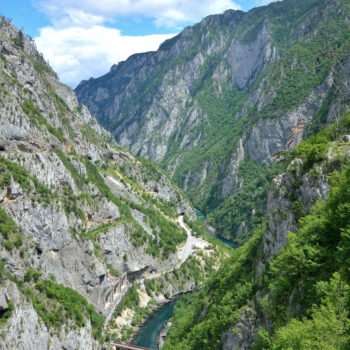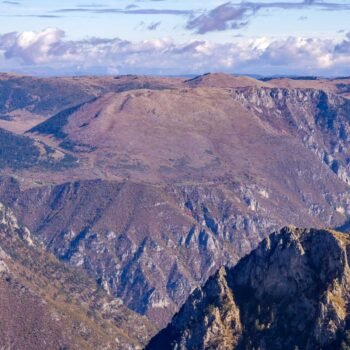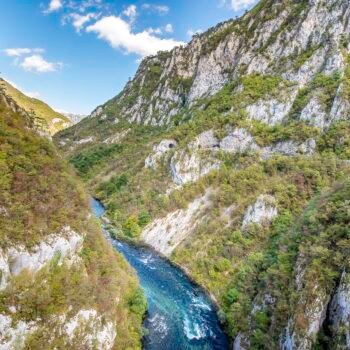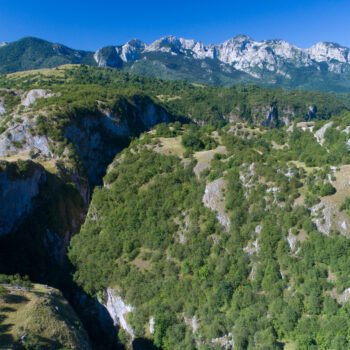- /
- Katun Road The Great...
- /
- Canyons
Canyons
TARA
Whoever passes through the Tara Canyon even once remains forever enchanted by this river.
Do we even need to list the facts? The Tara River Canyon is 60 kilometers long and ranks as the second deepest canyon in the world (after the Colorado River Canyon in the USA), and the deepest in Europe. Its average depth is 1,073 meters, with the deepest point reaching 1,333 meters. It is a sanctuary of untouched nature, a refuge for many endemic plant and animal species, and has been part of UNESCO’s “Man and the Biosphere” program since 1977 as an exceptional geomorphological and ecological whole. In 1980, along with Durmitor National Park, it was listed as a UNESCO World Natural Heritage site, fulfilling three criteria: geological, hydrological, and biological phenomena (only one is needed for listing).
Tara’s waters come from the surrounding snow-covered mountains, numerous springs, streams, and rivers. One of the most famous features is Bajlovica Sige, a cascade of waterfalls 150 meters wide where water flows from the Bucevica cave into the Tara, with drops up to 30 meters high.
The canyon is home to around eighty caves, most of which remain unexplored. Some contain evidence of prehistoric human presence. The origins of the name “Tara” are mostly explained by legends. It is known, however, that Illyrian tribes—most notably the Autariatae—once inhabited the riverbanks.
Rafting the Tara is more than just a tourist attraction. It’s an experience that changes something deep within you.
PIVA
The Piva River springs from the Sinjac source on Mount Golija. Between towering peaks (Volujak, Maglic, Bioc, and Piva Mountain), it carved a breathtaking canyon—33 kilometers long and up to 1,200 meters deep. It was once considered one of the most attractive canyons in the region. Then came human intervention. With the construction of the Mratinje hydroelectric power plant in 1976, the artificial Piva Lake was created. Yet the spirit of the canyon still lingers, and cruising across the lake reveals glimpses of the sunken canyon’s beauty.
North of the dam, the canyon continues until the Piva meets the Tara at Scepan Polje, where they form a new river—the Drina.
SUSICA
The canyon of the Susica River is no less impressive than those of the Tara and Piva. Located on the western slopes of Durmitor, within the National Park, it stretches for 14 kilometers.
Susica originates at about 1,300 meters above sea level and flows into the Tara at 512 meters. As its name suggests (from “susa” meaning drought), it is an intermittent river, disappearing underground several times before reaching the Tara. According to local accounts, it once had a steady flow but began to vanish underground after massive floods.
At the canyon’s bottom lies the stunningly beautiful Susicko Lake, which dries up completely in summer. Words cannot capture the majestic confluence of Susica and Tara canyons—you simply have to see it.
On the plateaus flanking the canyon are two authentic villages: Nedajno and Crna Gora. Although close in a straight line, the land route between them spans 16 kilometers.
Susica Canyon is a habitat for wild boars, deer, and chamois. In summer, they ascend toward Durmitor’s peaks; in winter, they descend into the warmer canyon.
An old mill once stood in the canyon, where residents of Piva Mountain would bring their grain to be milled.
NEVIDIO
You don’t have to pass all the way through this canyon—once completely unknown to man—to feel its breath and sense its uniqueness. Entering just 20–30 meters is enough. The Komarnica River is a marvel. It rises in Dobri Do, at the foot of Durmitor’s southern part. It disappears underground between Boljske Grede and Lojanik before re-emerging in a gentle valley as a “normal” river. At the end of the valley, it suddenly vanishes into a mysterious entrance—and this is where Nevidio Canyon begins.
Most of the canyon is in eternal shadow. In some places it is narrow enough to leap across, yet so deep and twisted. About 4 kilometers long, its nearly vertical walls rise up to 300 meters. The surrounding area is one of the most scenic in the Durmitor region, with the village of Poscenje and its two lakes, and the Skakavica Waterfall nearby.







